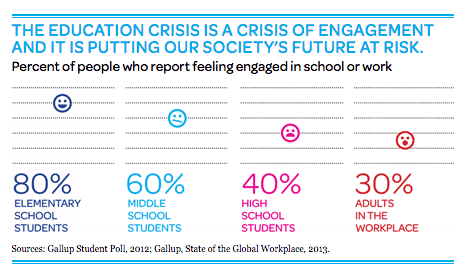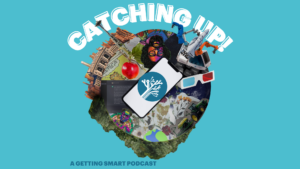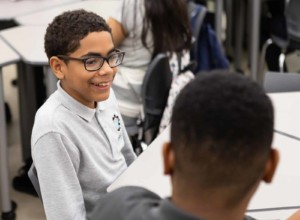9 Ideas for Combatting Boredom in School (and Why Being Bored May Not Be All Bad)

22,000 American high school students from public and independent schools participated in an online survey and were asked how they felt in schools. The predominant answers were “bored, tired and stressed.”
Let me start by saying not all boredom is bad.
The creator of the Tony award-winning musical Hamilton, Lin Manuel Miranda, wrote that he credits being bored in school with using his imagination and honing creativity.
Miranda wrote, “Time alone is the gift of self-entertainment—and that is the font of creativity. Because there is nothing better to spur creativity than a blank page or an empty bedroom. I have fond memories of pretending ninjas were going to come into every room of the house and thinking to myself, ‘What is the best move to defend myself? How will I “Home Alone” these ninjas?’ I was learning to create incredible flights of fancy.”
Interested to learn more about the issue of boredom, I asked friends and educators: What’s the opposite of boredom? What are ways we can combat boredom? And finally, should we?
Here are responses and takeaways from educators posted on my Facebook page for school this year:
Tell Stories
“Tell stories,” says educator Gary Heyde. Gary said his former students tell him that what they remember most is the stories he told them. He was also known to read books aloud such as Life of Pi and The Secret Life of Bees to his students. Storytelling is a well-documented engagement strategy and it was the primary way we learned before we started writing things down. And it’s a real art.
Tip: Listen to StoryCorps and The Moth Radio Hour for great resources and inspiration.
Create Opportunities To Be Active
Friend and educator Kanchen Schindlauer says active learning is key. My sister Brooke, a former English teacher and now a yoga teacher in Japan, agrees and writes the opposite of boredom is “physical engagement, breath, mindfulness. In other words, dance and do yoga.”
Tip: Find ways to incorporate play and movement in the classroom and outside.
Provide Choices
Jennifer Miller, who runs the blog Confident Parents, Confident Kids, said giving students choices and taking the initiative leads to more stimulation and curiosity.
Tip: Authentic and real world projects give students choices about their work that are aligned with interests and passions.
Allow For Students To Move At Their Own Pace
My cousin’s wife Karen Meador dropped out of high school. She went on to earn her MBA and MD. She was discouraged by her piano teacher for “jumping ahead” in her lessons. Karen writes, “Too often I think schools have a single curriculum that only works well for a small group of students in the middle. For some students, that is too fast and they can’t understand and keep up and for others it seems too slow. But it both cases it results in the feeling of boredom, because true learning is not taking place.” She advocates for allowing students to learn at their own pace instead of being grouped with all other students.
Tip: Competency-based learning strategies abound. See the latest on CBE from Chris Sturgis of Competency Works here.
 Play
Play
Educator Dorothy Lemout says play is the opposite of boredom–and there’s lots of research to suggest play is a great way to learn. The Institute of Play advocates for play-based learning. They write that “games support critical thinking and complex problem solving” and are “designed to create a compelling complex problem space or world, which players come to understand through self-directed exploration. They are scaffolded to deliver just-in-time learning and to use data to help players understand how they are doing, what they need to work on and where to go next. Games create a compelling need to know, a need to ask, examine, assimilate and master certain skills and content areas.” The Institute of Play has developed Quest to Learn, a public school in New York City that offers a new model for student engagement.
Tip: Get into games. As a parent or teacher, think about what games you love (indoor, outdoor, online) and use your own interests to guide what and how you interact with young people. See Getting Smart’s latest campaign on place-based learning to see how we are thinking about and talking about using sense of place to encourage equitable access to learning for all students.
Connect School To Real Life
David Levine, educator at Big Picture Learning, said, “The real world is pretty interesting. Internships and Leaving to Learn can be exciting and powerful.” The University of Helsinki has an extensive study about this, writes Lasse Leponiemi of Scool, a Finnish organization that helps lead school change. In the study, the authors write about students being “bored out”–a feeling used to describe the fact that students did not see the relationship between learning goals and “real life.” In other words, they felt that school was separated from their reality. To combat this, encouraging connectedness between school and the real world is critical for engagement.
Tip: Help students find adult mentors outside the classroom to support project work and interests.
Connect School To The Future.
Danielle Harder said, “I think it’s hard for everyone, but especially for teenagers to know what they don’t know. Being somewhat trapped in a predefined high school experience designed in previous centuries is predictably boring. Perhaps they need to be shown somehow that their future is theirs to make and let them have a significant team oriented project or problem to solve or solution to create to address a real world opportunity that could positively influence their own future.”
Tip: In a high school setting, asking students, “What’s your vision for your future?” and then listening may be the most powerful thing you as the adult can do.
Note: The listening part is important. Ask, then listen, then support. Once you’ve proven you will be there for them and respect them, gently push them to go deeper and further than they think they could.
Do More Projects
A former student of mine, Christina Postnikoff, recently wrote, “I think the best way to learn is trial and error, being hands on, learning through experience. Projects encourage that. The majority of life’s lessons are learned this way.”
Educator and friend Charles Houston Beaumont wrote, “Life doesn’t always happen in 45-90 minute blocks. It is important to learn how to complete a task that takes more than a school period.”
Tip: The team at Getting Smart is running a year-long campaign titled It’s a Project-Based World. Follow along at #ProjectBased for more information, to contribute your own stories and for updates on our three upcoming publications. Check out the hundreds of PBL blogs on GettingSmart.com as well as on the Buck Institute for Education’s site.
Encourage Students To Own Their Boredom…And Fix It.
Educator Nancy Flanagan writes, “I think the most useful thing parents, teachers (and students) can do to prevent genuine boredom is devise individual strategies to extend learning–read a different book, tackle a more challenging solo, ask for harder problems or other enrichments. Anyone who’s ever leafed through a well-used textbook knows that some kids know how to doodle their way to amusement. Tell your kids to own their boredom and fix it.”
One impediment to enacting these ideas may be the way in which schools are organized and how teachers are evaluated. Barriers to school and systems change could keep students in “boring” schools.
Tip: We’d love to hear from you. In the face of barriers, how are you as a teacher or as a parent helping to combat boredom (or framed more positively, how are you creating engagement)? And a related question: Is some boredom ok? What best practices exist to create engagement? We accept guest blogs. Make sure to follow our guest blogging procedures and email us at [email protected].
This blog is part of “It’s a Project-Based World” series. To learn more and contribute a guest post for the series, see the Project-Based World page. Join in the conversation at #ProjectBased.
For more, see:
- 5 Myths on Project-Based Learning Dissected and Debunked
- Is it a Project or an Activity? Project-Based Learning and its Cousins
- 3 Elements of Deeper Project-Based Learning
Stay in-the-know with all things EdTech and innovations in learning by signing up to receive the weekly Smart Update. This post includes mentions of a Getting Smart partner. For a full list of partners, affiliate organizations and all other disclosures, please see our Partner page.








Kurt
So on point. Who doesn't get bored at school? I'll be using these tips again when I go back to school at la salle zobel in a few months. I hope every educators would try incorporating play every time they teach!
Elizabeth M
This is great but what does a bored teen do?? Print this and give it t his teachers? Ugh. My kid has a very high IQ, already skipped a grade, and is bored out of his mind. So much so he's coming close to shutting down. A junior with a 4.7 is coming close to checking out. So sad.